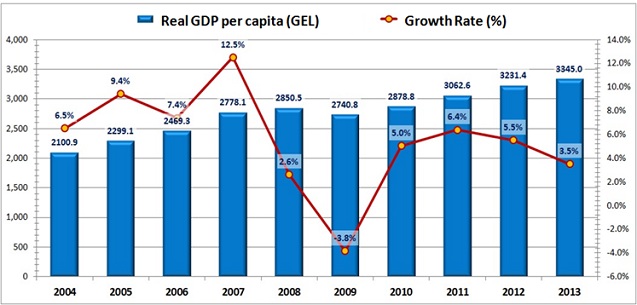On 21 February 2013, Giorgi Margvelashvili delivered his first annual Presidential Address in the Parliament of Georgia. The sitting was accompanied by debates between the Parliamentary Majority and the Minority. Giving a speech, Secretary of the faction Georgian Dream – Industrialists, Zurab Tkemaladze, discussed the ongoing economic processes in the country. As stated by the MP: “GDP per capita is still increasing, the tendency of growth has not stopped.” He further clarified that although in 2013 we witnessed certain drawbacks, the difficulties have been overcome. Moreover, starting from September 2013, the rate of economic growth has surged. According to Tkemaladze, the forecasts predicting the rate of economic growth to amount to 1-2% at most proved to be exaggerated. In the end, the indicator reached 3.5% and the International Monetary Fund and the World Bank foretell a 5% economic growth rate in the current year.
FactCheck inquired about the growth dynamics of the GDP per capita indicator and checked the accuracy of the facts indicated in the MP’s statement.
In line with the data of GeoStat, the real GDP per capita growth rate throughout the years 2003-2013 is as follows:
 As shown in the graph above, GDP per capita was seeing a growth in all years exclusive of 2009.
Note: Given the fact that the National Statistics Office has not yet published the final indicators of GDP per capita for the year 2013, FactCheck calculated the estimated indicators for 2013 independently. Specifically, our estimations are based upon the preliminary indicator of the real economic growth rate of 2013 published by GeoStat – 3.1%. We calculated the estimated volume of real GDP and divided it by the size of the Georgian population which amounted to 4,483,800 persons as of 1 January 2013. We estimated the real GDP per capita for 2013 based upon these calculations.
Conclusion
As revealed by our research, the GDP per capita growth rate was increasing in each year in the period 2004-2013 with the exception of 2009. A rise in the GDP per capita indicator was registered in 2013 as well but it is to be taken into consideration that the growth rate itself has dropped. The growth rate of GDP per capita as estimated by FactCheck (3.5%) is distinctly below the same indicators of previous years (except for 2008 and 2009; that is, the year of the Russian-Georgian war and the year following the incursion).
Therefore, the MP rightfully points to the growth of the GDP per capita indicator in 2013 but overlooks the fact that the witnessed growth rate falls behind the indicators registered in the previous years. Zurab Tkemaladze calls upon his political opponents to take notice of the GDP per capita growth whereas he himself fails to note the fact that the GDP per capita indicator of Georgia was increasing each year, exclusive of the year following the Russian-Georgian war. In the light of this fact, consideration is to be given not only to the fact of growth but primarily to the rate of growth which is significantly smaller in 2013 as compared to previous years.
Consequently, FactCheck concludes that Zurab Tkemaladze’s statement: “GDP per capita is still increasing, the tendency of growth has not stopped... why are we disregarding this fact?” is HALF TRUE.
As shown in the graph above, GDP per capita was seeing a growth in all years exclusive of 2009.
Note: Given the fact that the National Statistics Office has not yet published the final indicators of GDP per capita for the year 2013, FactCheck calculated the estimated indicators for 2013 independently. Specifically, our estimations are based upon the preliminary indicator of the real economic growth rate of 2013 published by GeoStat – 3.1%. We calculated the estimated volume of real GDP and divided it by the size of the Georgian population which amounted to 4,483,800 persons as of 1 January 2013. We estimated the real GDP per capita for 2013 based upon these calculations.
Conclusion
As revealed by our research, the GDP per capita growth rate was increasing in each year in the period 2004-2013 with the exception of 2009. A rise in the GDP per capita indicator was registered in 2013 as well but it is to be taken into consideration that the growth rate itself has dropped. The growth rate of GDP per capita as estimated by FactCheck (3.5%) is distinctly below the same indicators of previous years (except for 2008 and 2009; that is, the year of the Russian-Georgian war and the year following the incursion).
Therefore, the MP rightfully points to the growth of the GDP per capita indicator in 2013 but overlooks the fact that the witnessed growth rate falls behind the indicators registered in the previous years. Zurab Tkemaladze calls upon his political opponents to take notice of the GDP per capita growth whereas he himself fails to note the fact that the GDP per capita indicator of Georgia was increasing each year, exclusive of the year following the Russian-Georgian war. In the light of this fact, consideration is to be given not only to the fact of growth but primarily to the rate of growth which is significantly smaller in 2013 as compared to previous years.
Consequently, FactCheck concludes that Zurab Tkemaladze’s statement: “GDP per capita is still increasing, the tendency of growth has not stopped... why are we disregarding this fact?” is HALF TRUE.
 As shown in the graph above, GDP per capita was seeing a growth in all years exclusive of 2009.
Note: Given the fact that the National Statistics Office has not yet published the final indicators of GDP per capita for the year 2013, FactCheck calculated the estimated indicators for 2013 independently. Specifically, our estimations are based upon the preliminary indicator of the real economic growth rate of 2013 published by GeoStat – 3.1%. We calculated the estimated volume of real GDP and divided it by the size of the Georgian population which amounted to 4,483,800 persons as of 1 January 2013. We estimated the real GDP per capita for 2013 based upon these calculations.
Conclusion
As revealed by our research, the GDP per capita growth rate was increasing in each year in the period 2004-2013 with the exception of 2009. A rise in the GDP per capita indicator was registered in 2013 as well but it is to be taken into consideration that the growth rate itself has dropped. The growth rate of GDP per capita as estimated by FactCheck (3.5%) is distinctly below the same indicators of previous years (except for 2008 and 2009; that is, the year of the Russian-Georgian war and the year following the incursion).
Therefore, the MP rightfully points to the growth of the GDP per capita indicator in 2013 but overlooks the fact that the witnessed growth rate falls behind the indicators registered in the previous years. Zurab Tkemaladze calls upon his political opponents to take notice of the GDP per capita growth whereas he himself fails to note the fact that the GDP per capita indicator of Georgia was increasing each year, exclusive of the year following the Russian-Georgian war. In the light of this fact, consideration is to be given not only to the fact of growth but primarily to the rate of growth which is significantly smaller in 2013 as compared to previous years.
Consequently, FactCheck concludes that Zurab Tkemaladze’s statement: “GDP per capita is still increasing, the tendency of growth has not stopped... why are we disregarding this fact?” is HALF TRUE.
As shown in the graph above, GDP per capita was seeing a growth in all years exclusive of 2009.
Note: Given the fact that the National Statistics Office has not yet published the final indicators of GDP per capita for the year 2013, FactCheck calculated the estimated indicators for 2013 independently. Specifically, our estimations are based upon the preliminary indicator of the real economic growth rate of 2013 published by GeoStat – 3.1%. We calculated the estimated volume of real GDP and divided it by the size of the Georgian population which amounted to 4,483,800 persons as of 1 January 2013. We estimated the real GDP per capita for 2013 based upon these calculations.
Conclusion
As revealed by our research, the GDP per capita growth rate was increasing in each year in the period 2004-2013 with the exception of 2009. A rise in the GDP per capita indicator was registered in 2013 as well but it is to be taken into consideration that the growth rate itself has dropped. The growth rate of GDP per capita as estimated by FactCheck (3.5%) is distinctly below the same indicators of previous years (except for 2008 and 2009; that is, the year of the Russian-Georgian war and the year following the incursion).
Therefore, the MP rightfully points to the growth of the GDP per capita indicator in 2013 but overlooks the fact that the witnessed growth rate falls behind the indicators registered in the previous years. Zurab Tkemaladze calls upon his political opponents to take notice of the GDP per capita growth whereas he himself fails to note the fact that the GDP per capita indicator of Georgia was increasing each year, exclusive of the year following the Russian-Georgian war. In the light of this fact, consideration is to be given not only to the fact of growth but primarily to the rate of growth which is significantly smaller in 2013 as compared to previous years.
Consequently, FactCheck concludes that Zurab Tkemaladze’s statement: “GDP per capita is still increasing, the tendency of growth has not stopped... why are we disregarding this fact?” is HALF TRUE.








